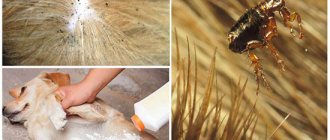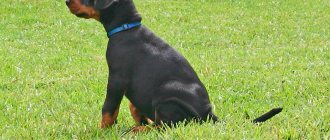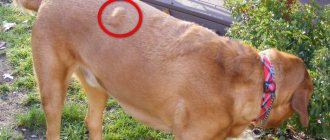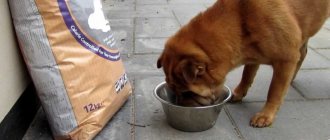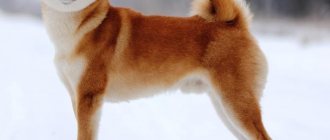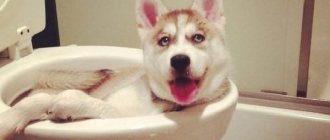A dog in the house is not only fun, joy and restlessness. First of all, it is worth remembering that the dog is more susceptible to infection with parasites such as fleas and ticks than any other pet. At the same time, regardless of the breed of the animal, every owner sooner or later faces the problem of fleas and asks how to remove fleas from a puppy, especially if he is still small.
Before you run to the pharmacy for medications, you should make sure that it is fleas that are bothering your dog. These parasites are distinguished by a reddish-brownish body color, flattened on the sides. Fleas jump high and move very quickly over the dog's body. If gray, white, or yellow parasites are found on the animal, then these are most likely lice and other means must be used to eliminate them.
The puppy has fleas. Causes and symptoms
Dogs that constantly walk outside are at risk of infection from yard dogs and other sources. But even if your puppy doesn't go outside yet, he can still be exposed to parasites. The reason is that a person, being on the street, can become, without knowing it, a carrier of parasites.
How to tell if your dog has fleas:
- the pet is constantly itching, anxiety is noticeable;
- at the sites of bites, the skin may turn red and swelling may appear;
- the fur begins to fall out in clumps;
- on the dog’s fur you can see white specks (parasite eggs) and black dots (parasite excrement);
- During washing, parasites can be easily detected - they run in panic onto the dog's head.
If fleas are found, immediate action must be taken as long-term exposure of the dog to parasites causes suffering and pain. For very young puppies, the case can be fatal.
To remove fleas from a puppy at home, you need to know what medications exist and how effective each type is.
Why are parasite bites dangerous?
An adult dog tolerates the presence of fleas better than a baby dog. Parasites are dangerous especially for the smallest dogs. The puppy is constantly itching, whining, and cannot find a place for itself; besides, fleas are dangerous for the kitten for other reasons:
- the dog’s immune system, which is not fully formed, allows any infection that a flea infects through a bite to easily penetrate into its body;
- one-month and two-month-old puppies often suffer from allergies to flea saliva enzymes;
- with a large number of bites, anemia may develop, as the dog loses a lot of blood;
- worms, which are caused by fleas, are very difficult for children to tolerate: bowel movements are disrupted, the dog weakens, becomes exhausted, and the coat becomes dull.
Be sure to treat your dog with an effective anti-parasite treatment before mating.
Today you can find various flea remedies on sale, but not all of them are safe for a small dog. The drugs are produced in the form of drops, sprays, shampoos and tablets. Anti-parasite collars are also very often used.
When can a puppy be treated for fleas?
There is a large selection of drugs and methods to combat parasites. But it is worth noting that for very small puppies (up to 1 month) none of the chemicals are suitable, since the baby’s immunity is still developing. Here you can only help mechanically. For this:
- The puppy is thoroughly washed in a decoction of herbs (wormwood, lavender) or with essential oils added to the water (cedar, pine needles, citrus). It is safe to use tar soap. Water should not get into the nose, ears, eyes;
- the dog is dried, laid out over a white cloth and the fur is carefully combed out with a thick comb;
- In parallel with this, the dogs’ habitat is treated – the bed and toys are cleaned using special means.
How to get rid of parasites in a one-month-old puppy
If a baby who is only 1 month old has fleas and they bite very hard, then it is necessary to get rid of the parasites at home radically, but at the same time, carefully.
Prepare a strong decoction from a mixture of tansy and wormwood (you can also take mint, calamus or wild rosemary). Immerse your baby in it, but make sure that the broth does not get into his eyes, nose and ears. Keep the puppy in this bath for 15 minutes. Then dry and thoroughly comb out the parasites over a white piece of cloth.
You can also poison blood-sucking insects from a month-old baby with tar soap. Wet the puppy thoroughly, then soap it generously. Then wrap it in film and wrap it in a towel or wool blanket. After 20 minutes, thoroughly rinse off the foam containing the killed pests from the puppy, dry and comb out flea eggs and larvae from the fur.
How to remove fleas from a puppy at 1 or 2 months old
The older your dog gets, the more flea treatments you can use. So, among the assortment for older pets, you can choose the following drugs.
Drops
Flea drops for puppies are distinguished by the fact that they provide a long-lasting effect. But the disadvantage of this drug is that most drugs of this form are intended for older pets. The most effective flea drops for puppies from 2 months of life:
- Frontline - suitable for animals weighing more than 2 kilograms;
- Celandine – contains more plant substances, therefore it is safer for the baby’s health;
- Barrier, Blochnet, Advocate, Advantix - drops produced by well-known manufacturers. All of them give a quick effect, but it is better to first check with your veterinarian that such drugs will be safe for your dog.
Flea and tick drops for puppies are easy to use - they are applied to the skin under the fur in places where the dog cannot reach and lick them off. It is better not to use this type of medication if the baby is still with the mother.
Flea shampoo for puppies
Shampoo is a recommended product that can be used to remove fleas from a 1 month old puppy. There are a lot of types of shampoos - to treat a dog you need to apply shampoo to wet fur, lather and hold for 3-5 minutes.
After this, the shampoo is washed off with plenty of water. Such products get rid of parasites due to their pungent aroma, but to ensure that all fleas are driven away, it is better to use this method together with mechanical cleansing.
It is worth noting that now you can find two types of shampoos on sale - for one-time getting rid of parasites and for prevention. The first type is more toxic, but helps quickly eliminate parasites. The second is safe for health and helps not only to prolong the effect of protection against re-infection, but also gives the coat a healthy shiny appearance. It is recommended to use shampoo in combination with other methods of control.
Flea and tick spray for puppies
The most popular flea treatment for puppies at 2 months is a spray. It is easy to apply, it is highly effective, long-lasting and safe for the baby’s health.
Among flea sprays for puppies, we can highlight Bars, Frontline, Stronghold - they are applied to the fur until lightly moistened, then the puppy cannot be bathed for 2-3 days, during which the parasites will be completely destroyed.
Flea collar for puppies
A flea and tick collar for puppies is a product that is designed for older individuals. But even for the age of 1.5-2 months you can find several suitable specimens. Among them, it is worth noting Bearphar and HartZ, which are designed with a high degree of safety for the health of children.
This is the most effective flea and tick treatment for puppies because it prevents parasites, can be bathed, and does not require the use of other medications.
But before you put such a device on your animal, find out how toxic the collar is and whether it can be worn constantly. It often happens that constantly wearing a flea collar causes dermatitis and allergic reactions. So it is better to wear such a collar only when walking and in contact with other dogs.
Therapy up to 8 weeks
Removing fleas from a puppy
After 30 days of life, the animal’s body becomes stronger, immunity increases, internal organs begin to work in a balanced manner, and the skin resists external irritants. If your puppy has fleas, they can be dealt with much faster and can provide protection for at least a week.
Folk remedies for fleas for puppies:
- Dust, tar soap. Bathe your pet and leave the foam on for up to 15 minutes. Combing is carried out. Soap is a natural insecticidal substance and therefore requires compliance with the rules. You cannot keep it on the skin for longer than 15 minutes; you can repeat the procedure after a week.
- Essential oils. Add to shampoo or dilute a few drops in warm water and spray onto the dog’s fur. To increase efficiency, it is recommended to combine the method with combing. Fleas are afraid of the smell of mint, lemon balm, rosemary, lavender, and citrus fruits. Provide additional protection against bloodsuckers for up to 7 weeks.
- Decoctions. A flea remedy for dogs based on herbs - wormwood, tansy, chamomile, and garlic. Pour boiled water over it and leave for at least 30 minutes. They drip in hard-to-reach places to prevent your pet from licking it off. The best option is at the withers. The procedure can be repeated after 3 days.
- Hellebore water. The product is sold at the pharmacy. Apply to the coat with a washcloth and leave for 20 minutes. It is necessary to ensure that the pet does not lick the drug, wrap it in a towel, and hold it in your arms. Rinse thoroughly with warm water. Removal of the flea family ends with combing.
Treatment for fleas and ticks in a puppy using folk remedies
You can get rid of fleas on a puppy at home not only with the help of chemicals.
To protect your pet and subsequently prevent re-infection, you can use folk remedies. You can protect your puppy from ticks and fleas using basic ingredients.
Medicinal herbs
The best way to deal with parasites is a decoction of wormwood, which has a distinct, specific odor. It causes parasites to leave the animal in panic within the first minutes after treatment.
Essential oils
Cedar and lavender are scents that fleas cannot tolerate. To treat, dissolve 5-10 drops of oil in water and wipe the animal’s fur.
Garlic and onion
Natural antioxidants that can quickly drive away parasites. To do this, you need to extract juice from vegetables. When treating a dog, do not apply the juice to places that it can reach with its tongue, so as not to get poisoned.
Needles
The needles do an excellent job of removing parasites. Adding pine sawdust to your dog's bed will help prevent re-infection even more effectively.
Lemon and citrus
Lemon and citrus - this scent, despite its restraint, is also very disliked by fleas.
Ways to get rid of parasites
When a dog is still very young, he is usually with his mother and the rest of the litter. Children usually begin to be distributed no earlier than 1.5-2 months. Therefore, the ways to remove fleas from a puppy who is 1 month old and 2 months old at home will be different. The presence or absence of a dog family is taken into account.
1 month.
If your baby is not yet 1 month old or has just turned 1 month old and is actively being bitten by insects, then you need to take drastic measures. If the dog is in a litter, you will have to treat all of them at once. How to remove fleas from puppies up to a month old?
- Use shampoos for the smallest puppies. Good ones, for example, are Doctor Zoo. It does not contain insecticides, but only natural ingredients. Lather your baby, hold the foam for about 5 minutes, then rinse. For very young puppies affected by insects, it is recommended to apply whipped foam directly to dry fur and then dry it.
- Another good way to remove fleas from a shepherd puppy is to bathe him in tar soap. After lathering him well with soap, wrap the baby in a diaper, and throw something warm on top so that he does not freeze. After 20 minutes, the product should be washed off, then dry the dog and comb him thoroughly.
- Prepare a strong decoction of wormwood or tansy. You can combine two herbs, or use mint, calamus, and bogulnik. Immerse your pet in a warm broth (make sure that the water does not get on the head, especially on the eyes, mouth, and ears). Soak the baby in the broth for at least a quarter of an hour, then dry and comb out.
2 months.
When the puppy is 2 months old, he already has milk teeth, his immunity has been formed, his body weight has increased, he begins to receive a varied diet, and not just mother’s milk, so the question of how to remove fleas at home will be much easier to solve.
- From this age on, the range of anti-parasite shampoos expands significantly. Still, up to six months, it is better to give preference to products containing a minimal amount of insecticides, or not at all. If there are several dogs, it is necessary to dry each one well before letting him in with the others.
- You can remove fleas from a two-month-old puppy using collars, but you should choose ones specifically designed for younger dogs - they are soaked in various essential oils. If there are several puppies in the house, it is better not to use collars at all, as there is a chance that the kids will chew on each other’s collars.
- How to remove fleas from a puppy who is still 2 months old? A good option is drops. But, again, you need to read the instructions carefully. It is important that the drug is not contraindicated for the baby by age.
Rating of the best funds
Below is a rating of products that can be used to remove fleas from a puppy:
Stronghold.
One of the most effective drugs for fighting parasites, which includes selamectin. The substance affects both adult insects and larvae, and also destroys scabies mites and some types of helminths.
The drug has been tested on 167 dog breeds and is suitable for removing fleas from a toy terrier puppy and sensitive breeds such as collies. In all cases, its high effectiveness and safety have been proven. Apply drop by drop
along the spine, quickly absorbed, used for puppies from 6 weeks of age.
Leopard.
The domestic product, however, is absolutely no worse than its imported counterparts. Contains praziquantel and ivermectin, which protect the dog from fleas, ticks and helminths.
Suitable for dogs 2 months and older.
Dana.
Drops from the Api-San company are intended for dogs from 2 months. Composition: diazonin.
The product is applied along the animal's spine and thoroughly rubbed into the skin to prevent licking. It is not recommended to bathe your dog three days before applying the drops, and for three days after.
Where you can buy these drugs, you can see in the table:
| Pharmacy name | Address | Name of drops and price |
| Pet shop Pet | Moscow, st. Leninskaya Sloboda, 26, building 2 | Dan drops – 125 rub. |
| CatDog | St. Petersburg, 4th Krasnoarmeyskaya st., 12/11, t. | Stronghold – 100 rub. for one pipette. |
| Zooexpress | Minsk, st. M. Bogdanovich, 114 | Drops Bars – 17,000 rub. |
| Murzilka | Kyiv, Goloseevsky district, Oleg Koshevoy street 2A | Drops Bars – 70 UAH. |
In addition, for puppies two months old, you can already use sprays that allow you to quickly and completely get rid of fleas.
Traditional methods
In terms of effectiveness, folk remedies for fleas are, of course, inferior to almost all anti-flea drugs, but their main advantage is safety. You don’t have to worry that a decoction of wormwood, chamomile, or tansy will cause any harm to your pet. Folk remedies are most effective when the number of parasites is small.
So, how can you remove fleas from puppies at home, without resorting to professional remedies? The following remedies are most effective:
- sagebrush;
- tansy;
- eucalyptus;
- pine sawdust.
From the above raw materials, you can prepare infusions and decoctions that can be used to treat dog fur or use them for bathing. In addition to safety, such methods are also easily accessible, especially if you do not have the opportunity to purchase special medications.
What should not be used to treat small puppies for fleas? Do not use garlic under any circumstances. It is poisonous to small pets and can cause serious intoxication of the body.
Prevention measures
As we can see, there are not many drugs that can be used to remove fleas from a 1-2 month old puppy. Therefore, you should not neglect preventive measures.
Prevention of parasites in puppies and dogs involves the following measures:
- Regular examination of the animal to detect bloodsuckers. If you find even one flea in your house or on your dog, know that there are already many mature insects, eggs, pupae and larvae somewhere nearby. Inspections are especially important in the spring and summer, when favorable temperature conditions for reproduction are created for parasites;
- Constant cleaning of premises where animals live. It is necessary to thoroughly vacuum all surfaces and wash bedding regularly;
- Once a month (less often in winter), it is advisable to use pest control products. If the puppy is very small, shampoos and collars that repel bloodsuckers are preferable;
- periodically combing your beloved pet with a special comb.
It is believed that the most likely source of flea infestation is stray animals. This is true, because no one removes parasites from poor homeless dogs. Therefore, you should not allow your pet to come into close contact with them.
You should also not forget that a puppy can pick up pests on an ordinary lawn or in the yard of a house, so you will not be able to constantly keep the animal in sterile conditions, no matter how hard you try.
Just try to carefully monitor your pet’s behavior and be prepared at any time to repel the attack of parasites by treating it with special means in a timely manner.
What to do if children live in the house with a flea-ridden puppy?
- First of all, don't panic. Although fleas can bite your beloved child, they do not live permanently on humans. Therefore, you should not think that pests will begin to jump en masse from the animal’s fur onto the baby’s head;
- secondly, still protect the child from the pet until you remove the insects. Children are more sensitive to flea bites and may experience allergic reactions. Therefore, it is first recommended to move the pet to a room different from the child, and then you can remove fleas from the puppy;
- Thirdly, it is necessary to fix the problem as soon as possible. Moreover, it is not only the animal itself that will have to remove parasites, but care must be taken to ensure that they are not left in the house. It is necessary to treat the animal’s bedding and the places where it most often happens;
- fourthly, after treatment, the child should not be allowed to contact the pet for several hours - while the insecticide is still in effect. Then you can safely allow your baby to play with his four-legged friend.
Flea treatment for a puppy: main rules
The most important thing is to start treatment as soon as possible in order to prevent the massive proliferation of parasites. It is best to consult a veterinarian before treatment to be sure that the chosen method of treatment is correct.
It is important to carefully follow the instructions for using the product - too much can have a detrimental effect on the puppy’s health, and too little or no re-treatment can lead to the rapid proliferation of parasites on the dog’s body.
We should not forget about prevention not only of the animal itself, but also of the entire apartment in which it lives, since fleas only feed on the dog, but they prefer to live in carpets and other textiles.
Symptoms and external signs
The first and main sign that your pet has fleas is its constant scratching. He can also chew his fur. And it is possible to find out whether the puppy was really attacked by parasites only through a detailed examination. You can comb against the grain to check for the presence or absence of bloodsuckers. They usually like to be located behind the ears, as this area has thinner skin and is easier to bite.
Fleas can also be detected during water procedures. Insects will jump off the pet or try to move to drier parts of the body.
Flea saliva causes very strong allergic reactions in babies, so redness will be another symptom. Sometimes it happens that due to the negative effects of parasites, hair loss may occur. Therefore, it is worth closely monitoring changes in the dog’s behavior and appearance.
Prevention
Protecting your puppy from fleas is an almost impossible task, but you can significantly reduce the risk of infection. To do this, you need to follow simple preventive measures:
- regularly examine the puppy for parasites;
- keep the dog's place clean, periodically treat the dog bed, kennel or enclosure with antiparasitic agents;
- regularly use flea protection products (collar, drops);
- avoid contact of the puppy with stray animals;
- When walking, avoid places that may be infested with fleas, such as overgrown wastelands.
These recommendations apply not only to puppies, but also to adult dogs.
What do fleas look like on dogs? (photo)
The flea's body has a laterally compressed shape and is covered with scales, bristles and spines. In length it reaches from one to five millimeters, although there are especially twice as many. The mouthparts are piercing-sucking type. Fleas do not have wings, which gives them additional maneuverability in the thick fur of animals. The long, strong limbs on the abdomen allow them to move quickly. The photo shows what fleas look like on a dog under a microscope and in real size.
Where do dogs get fleas?
Where can a dog pick up fleas and where do they come from? Anywhere, in fact. Fleas can live both outdoors and indoors, in basements. In the grass, in fallen leaves and even on bare ground. The risk of infection is always present, whether the dog is walked in the yard of a house, in specialized areas or in a dense forest. Even a dog that is not outdoors can be infected with parasites from other pets or neighbors. Fleas easily migrate from the entrance to the apartment through the open front door.
Parasites are incredibly jumpy, so even if you don’t let your pet get too close to other four-legged animals, you can’t be completely sure of its safety.
Many owners are very surprised how their exclusively domestic pet was able to “catch” parasites? It's very simple; insects and their larvae can be carried on clothes or the soles of shoes. They can enter the house even through open windows on the first floors.
Are these really fleas?
First of all, make sure that your pet is itching because of fleas.
- If you notice a rash, redness or dandruff, it is most likely an allergy.
- If the skin is clean, perhaps the baby is simply growing new fur.
- Well, if parasites appear in the fur, then the diagnosis is correct and the animal needs to be treated.
Important ! Preparations that are used to treat insects in adult dogs are not suitable for a puppy, as they can harm a fragile body.
Ridding your home of fleas, eggs and larvae
It is important not only to treat puppies, but also to treat the dog’s home, where the parasites themselves and their larvae gather. Female fleas lay many eggs, which fall on the floor, litter, and after a few days cocoons appear. They turn into adults and move on to people and dogs.
Attention! Fleas are localized on the dog, and their larvae and eggs remain on carpets and other objects in the house.
For treatment, special drops, sprays and regular vacuuming should be used. Pharmaceutical preparations contain substances that stop reproduction, which provides long-term protection against re-infection. After treating the puppy, you need to apply the product in places where the animal frequently rests (bedding, kennels, floor crevices and baseboards). After a couple of hours, open the windows for ventilation and clean the surfaces with a vacuum cleaner.
Features of treatment for puppies
When choosing a drug that will relieve the problem, you need to take into account the age of the baby. The younger he is, the less aggressive the components in the shampoo or drops should be, so as not to further damage or dry out the baby’s skin. In the first 6-8 weeks of his life, it is better to use simple methods of control; they will not be so effective, but safe for health.
To remove fleas from a puppy, it is important not only to use a special product, but also to clean the room at the same time. If there are other pets in the house, they should also be checked for insects.
Fleas on a 1 month old puppy
For a one-month-old puppy, even the most famous companies do not produce products to combat uninvited guests. You should not buy shampoo for older newborns; it is better to opt for traditional and mechanical methods:
- The first way is to bathe the puppy in a strong decoction of wormwood, tansy, wild rosemary or mint. Be sure to ensure that the drops do not get into the ears, nose and eyes. You need to keep your dog in this bath for at least 15 minutes. If all the offspring are infected, then bathe each puppy separately. After bathing and drying, the coat must be thoroughly combed over white paper or cloth to remove any fallen fleas;
- the second method is similar to the first, only using tar soap, which also has a pungent and repellent odor. First, wet the puppy with water and soap it generously, then freeze in a towel and a warm blanket so that he does not freeze, and hold this “mask” for at least 20 minutes. After this time, thoroughly rinse off the foam along with the dead fleas and do not forget about control combing , as in the previous paragraph;
Active ingredients such as herbs and tar will not harm the baby's skin and will not cause irritation or an allergic reaction, even if the puppy is only 2 weeks old. Therefore, they can be used for two-week-old babies and even newborns. But we must not forget about their mother - the main source of trouble.
Fleas on a 2 month old puppy
At this age, the feeding period has already ended and the offspring already have a more developed immune system, milk teeth and a strong physique. Therefore, it will be easier to exterminate fleas from such a puppy, since long-term preventive measures can be used.
- For this age, companies produce a large number of shampoos, but up to six months it is better to choose drugs with a minimum content of poisons, or better without them at all;
- Now you can buy collars designed for puppies and soaked in essential oils. But such a remedy will be ineffective if there are several puppies in the house due to the fact that they will chew each other’s collars and render them unusable;
- drops on the withers should be used based on the instructions and the age of the baby. Again, this method is suitable for a puppy living separately, since others may get poisoned;
- It is possible to use a spray that allows you to quickly and completely remove parasites, which are again allowed for this age. But, as with other products containing insecticides, they are contraindicated in litter.
Signs of fleas in a dog
The main signs of a dog being infected with fleas are:
- restless behavior and aggressiveness;
- constant scratching;
- increased shedding and the appearance of bald spots;
- wounds, sores and redness on the skin.
If symptoms are detected, it is necessary to examine the dog's coat. Pay special attention to the places on the withers, belly and behind the ears. Small brown insects, white eggs or tiny dark balls of excrement are fairly easy to spot.
How to remove fleas from older puppies
For an older dog, most insecticidal preparations against parasites widely available on the market are suitable. After reaching six months, you can use adult products, taking into account weight and age restrictions.
- Shampoos;
- sprays;
- pills;
- drops on the withers;
- collars.
Here it is important to take into account the tendency to allergies, the general condition of the dog, and the degree of flea damage. If there are a lot of bloodsuckers, then for a better result you can combine means: wash the puppy with shampoo, and then treat it with a spray or drops, or put on a collar, or even give him a pill. You decide!
Traditional methods
They were mentioned a little earlier, as they are applicable for newborn babies. Traditional methods are based on the use of herbs. That is why they are so harmless for newly born puppies.
If the mother and offspring are in an enclosure or in a room separate from human habitation, then it would be good to place bunches of herbs such as wormwood, lavender, and bugs around the bed. They have a pungent odor that will repel nasty insects. For the convenience of animals, the bunches can be replaced with powder from the same plants. Herbs are safe even for babies, who may accidentally get the herb inside.
If animals live in the house, then the litter and the surrounding area should be treated with water with the addition of a couple of drops of essential oil of the same lavender, lemon, menthol or eucalyptus. This method also has a deodorizing and antimicrobial effect.
Do not forget about baths using herbs that have a pungent and repellent odor.
Folk remedies
The use of folk remedies does not give immediate results, but can be used for puppies. To work you need soap, a comb and making your own shampoo. Processing progress:
- Bathe the dog in soapy water with intensive soaping for up to 10 minutes. Rinse the coat with plenty of water to remove most of the fleas. It is best to use tar soap.
- Carefully comb the animal with a brush or comb.
- Make your own shampoo, for which you need a few drops of celandine, equal portions of eucalyptus, tea tree, and cedar oils. Rub the mixture over your body and rinse after 15 minutes. The product is considered ideal against fleas for puppies.
The described recipe is effective, but to secure it, you can also apply flea drops, buy a collar, or use a spray.
The best folk remedies for fighting fleas
